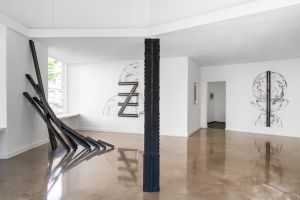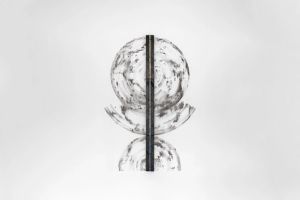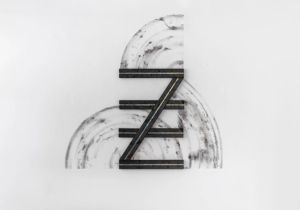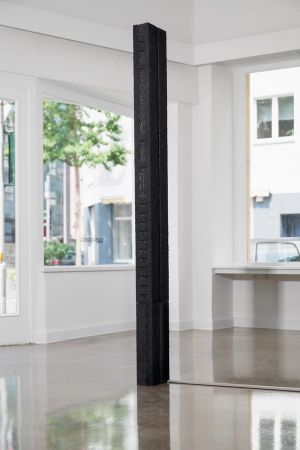GATHERING Roonstraße 108 Cologne
Stepping into AD proffers a portal into artist Seffa Klein’s world building. In the gallery space in Cologne visitors are confronted with a transmuted construction site. Materials give way to metaphors and each work takes on a certain role: Woman is an object of worship; SK Bricks (Gravity’s Grace) is a time-keeping device, aurally enhanced with the sound of falling water; physical structure or architecture is rendered through Röntgen Build; Motives represents desires and drives; and finally, social structure and economy are reflected in Wave (Lumber for Sale).
The title of the show, AD, is open to many interpretations, leaving the agency to the viewer to create their own definitions and their own world building. AD invokes Anno Domini (the Western calendar’s sacred zero), ad (Latin for “toward”), or perhaps advertising, furthered through the “branding” of works through their titles, like SK Bricks.
Born in Phoenix, Arizona, French-American artist Seffa Klein’s multidisciplinary practice fuses the conceptual, spiritual and meditative through a profoundly physical process. Klein’s upbringing in Sedona – stargazing and meteor watching in the desert – cultivated her passion for cosmologies, astrophysics and the desire to discover the mysteries of the physical and spiritual world. The desert, filled with essential materials, proved an especial significance to Klein, who encountered bismuth there in abundance.
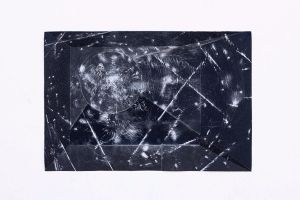
Bismuth, a naturally occurring metallic element hailing from collisions between neutron stars, represents, in the artist’s own words, ‘one's connection to the divine, one's self, one's metaphysical abilities.’ In Klein’s artistic practice, the metal works in diametric contradiction: elemental and found in the earth’s core, yet formed in high energy events in the universe, it represents both the elemental and cosmic, the material and immaterial. Known for its aesthetically-pleasing physical qualities and low melting temperature, Klein applies it in a molten state to her works, embedding them with a metaphysical quality.
In mathematics, elegance refers to a special kind of efficiency and beauty in the structure or solution of a problem – particularly when the complex is described clearly, precisely and succinctly. Wave (Lumber for Sale), in this tradition of elegance, transforms singular planks of wood. Separated from their original state of raw materiality, the planks can be read as units of time, consumption, action or invitation. The title’s humorous ode to the commodity language in which wood is purchased plays with the transactional nature of art, but also accentuates that these are updated units. Each plank – charred and imbued with bismuth – when stacked in formation collectively metamorphosises into a wave. The rectilinear evolves into the organic, manifesting the certain ways meaning can be reassembled. Planks of wood are an offering, an invitation for visitors to not only buy, but to take on as an ideology: how have wooden planks built our civilisation and how can we continue to build in different and sustainable ways?
Klein began her SK Bricks series in 2017; since then, each brick the artist makes becomes part of the ongoing sculpture. For the first time, the form of the series is changed with SK Bricks (Gravity’s Grace). Here, the artist created a new model of the brick to echo the shape of the planks in Wave (Lumber for Sale). Klein infuses her bricks with what she calls ‘a higher intelligence’: with a three to one chromosomal ratio of female to male features, the 40 bricks in the work interlock and create an in-out shape reminiscent of Brancusi’s column. Klein examines the brick – a brute unit used for the last 7,000 years – as a structure employed to create reality. The chameleonic nature of the bricks allows them to stand for anything that shapes our identity – our assumptions, social structures, constructs, architecture – highlighting the material and immaterial systems that construct us, reckoning with us to question what we are really made of and what constitutes the nature of being.
The continuity between the planks and the bricks emulate the interwoven nature of AD as a whole. Much like a construction site where every material contributes to the final building, each work is integral to the whole of Klein’s exhibition, formed (consciously and subconsciously) by the shape of the gallery space, the location in Cologne, the timing and Klein’s personal journey, resulting in a site-specificity in ways both material and immaterial.
Within this metaphysical convalescence, the context of Cologne permeates throughout the show and lends much significance. Röntgen Build draws from the German architecture style Fachwerkhaus, which translates to "half-timbered house" or "timber-framed house" in English. With a wooden framework exposed on the outside of the building, the materials are made visible.
The title Röntgen Build evokes the figure of Wilhelm Conrad Röntgen, a German physicist chiefly associated with discovering X-rays. Klein’s wooden planks revel in obviousness – situated within the architectural integrity of Fachwerkhaus that reveals its own materials – but also, through alchemical processes, highlights hidden structures and brings them to the forefront, much like the X-ray. Compositionally, Röntgen Build, like Woman and Motives, features planks that the artist has charred and then used to draw circles on the wall with its carbonised surface. Liberating the plank from its standardised use, the artist cultivates new forms. Carbon, the basis of all living beings, gives the forms a new life.
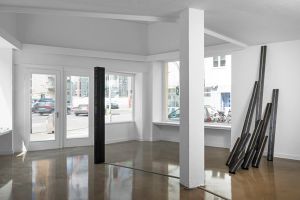
Inlaid with bismuth, Woman draws from a lineage of sacred geometries and divine figuration to reimagine the feminine. Permeated with references from Leonardo da Vinci’s Vitruvian Man to the Venus of Willendorf, the canonisation of saints to the veneration of goddess figures, to the root of life – the womb, the concentric circles radiating from the core of Woman see the body as spiritually, intellectually and metaphysically uncontained.
Motives: is it a diagram or an impulse? A performance or a reverberation? Planks are choreographed in an endless dance of push and pull, while residues of their carbonised surfaces in the forms of arcs and circles act as echoes of actions that came before. Motives explores the invisible forces that move us, from the molecular to astronomical and from our inner impulses to our dreams. On this wall, the subconscious is rendered real, our intuitions surface as swooping physical gestures.
Klein’s drawings, created through kismet while sanding the wall for the surface of the planks, provide the final element to the interwoven nature of AD. Titled after the location where the sanding was taken with the different grits, the drawings emphasise the experimental nature of Klein’s practice. The artist’s actions - the different ways of swiping on the wall and piecing the different grits together - fuse the cosmic results of arbitrary actions and Klein’s interest in uncovering the physical world. Both the title and the works of AD elude any single definition. If the show is about lived ontology and how both the physical and intangible can structure one’s perception, the works do not want to provide the answers. Rather, the artist, through open-ended discourse, is interested in the beauty of the undefined, connecting visitors with the opportunity to become in touch with their own drives and forces within themselves.
Photography by Volker Crone
